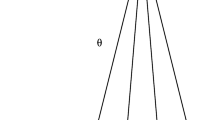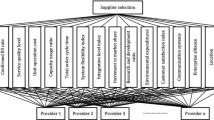Abstract
As an important branch of modern decision-making science, the theory and method of multi-attribute decision making have been widely used in many fields, such as society, economy, management and military affairs. Automobile industry as one of the typical manufacturing industries, in this wave, ushered in a transformation and upgrade to get rid of the current weaknesses and difficulties of rare historical development opportunities. Under the environment of Internet and big data, the construction of a new production and operation organization model of the smart car industry will promote its transformation in product planning, design, production, marketing and operation and maintenance. It is propitious to realize the service innovation facing the whole life cycle of the product. In view of this, this paper applies multi-attribute decision making to automobile manufacturing and service industry, taking 14 attributes of manufacturing and six attributes of automobile service as input, and training by BP neural. Finally, an example is given to verify the effectiveness of the method, and the average accuracy is 93.19%.




Similar content being viewed by others
References
Kumar M, Mao YH, Wang YH, Qiu TR, Yang C, Zhang WP (2017) Fuzzy theoretic approach to signals and systems: Static systems. Inf Sci 418:668–702
Zhang WP, Yang JZ, Fang YL, Chen HY, Mao YH, Kumar M (2017) Analytical fuzzy approach to biological data analysis. Saudi J Biol Sci 24(3):563–573
Wei G, Lu M (2018) Pythagorean fuzzy power aggregation operators in multiple attribute decision making. Int J Intell Syst 33(1):169–186
Shi L, Ye J (2018) Dombi aggregation operators of neutrosophic cubic sets for multiple attribute decision-making. Algorithms 11(3):29
Liu P, Liu X (2018) The neutrosophic number generalized weighted power averaging operator and its application in multiple attribute group decision making. Int J Mach Learn Cybern 9(2):347–358
Tang X, Huang Y, Wei G (2018) Approaches to multiple-attribute decision-making based on Pythagorean 2-tuple linguistic Bonferroni mean operators. Algorithms 11(1):5
Wei G, Gao H, Wei Y (2018) Some q-rung orthopair fuzzy Heronian mean operators in multiple attribute decision making. Int J Intell Syst 33(7):1426–1458
Liu P, Teng F (2018) Some muirhead mean operators for probabilistic linguistic term sets and their applications to multiple attribute decision-making. Appl Soft Comput 68:396–431
Yin K, Yang B, Li X (2018) Multiple attribute group decision-making methods based on trapezoidal fuzzy two-dimensional linguistic partitioned Bonferroni mean aggregation operators. Int J Environ Res Public Health 15(2):194
Huang YH, Wei GW, Wei C (2018) VIKOR method for interval neutrosophic multiple attribute group decision-making. Information 8(4):144
Wang J, Tang X, Wei G (2018) Models for multiple attribute decision-making with dual generalized single-valued neutrosophic Bonferroni mean operators. Algorithms 11(1):2
Fan C, Fan E, Ye J (2018) The cosine measure of single-valued neutrosophic multisets for multiple attribute decision-making. Symmetry 10(5):154
Liu P, Li Y, Zhang M et al (2018) Multiple-attribute decision-making method based on hesitant fuzzy linguistic Muirhead mean aggregation operators. Soft Comput 22:1–12
Teng F, Liu P, Zhang L et al (2019) Multiple attribute decision-making methods with unbalanced linguistic variables based on Maclaurin symmetric mean operators. Int J Inf Technol Decis Making 18(1):105–146
Alquran A, Hassan N (2018) The complex neutrosophic soft expert relation and its multiple attribute decision-making method. Entropy 20(2):101
Joshi R, Kumar S (2018) A new parametric intuitionistic fuzzy entropy and its applications in multiple attribute decision making. Int J Appl Comput Math 4(1):52
Teng F, Liu P (2019) Multiple-attribute group decision-making method based on the linguistic intuitionistic fuzzy density hybrid weighted averaging operator. Int J Fuzzy Syst 21(1):213–231
Wo-Yuan LI, Qiao JM (2018) A method for interval-valued intuitionistic fuzzy multiple attribute decision making based on expected values and its application. J Inner Mongolia Univ 49(1):52–57
Dai ZH, Chen JQ, Dai Y (2018) Clustering algorithm of wireless sensor networks based on OWA multiple attribute decision. Electron Des Eng 26(2):144–148
Li Y, Tong N (2018) Multi-objective optimization of micro-grid operation based on multiple attribute decision making. Electr Meas Instrum 55(4):55–60, 69
Che Z, Purushotham S, Cho K et al (2018) Recurrent neural networks for multivariate time series with missing values. Sci Rep 8(1):6085
Huang DS, Chi Z (2001) Finding complex roots of polynomials by feedforward neural networks. In: International joint conference on neural networks (IJCNN’01). Proceedings (Cat. No.01CH37222), vol Addendum, p A13
Xie MC, Han X, Luan S et al (2018) Brain tumor segmentation using convolutional neural networks feature extraction in MRI images. J Qufu Normal Univ 25(2):49–53
Desai VS, Conway DG, Crook JN et al (2018) Credit-scoring models in the credit-union environment using neural networks and genetic algorithms. Ima J Manag Math 8(4):323–346
Jiang YG, Wu Z, Wang J et al. (2018) Exploiting feature and class relationships in video categorization with regularized deep neural networks. In: IEEE transactions on pattern analysis and machine intelligence PP(99):1–1
Wang Y, Kosinski M (2018) Deep neural networks are more accurate than humans at detecting sexual orientation from facial images. J Pers Soc Psychol 114(2):246–257
Krestinskaya O, Salama KN, James AP (2018) Analog backpropagation learning circuits for memristive crossbar neural networks. In: IEEE international symposium on circuits and systems. IEEE
Thuan MV, Tran HM, Trinh H (2018) Reachable sets bounding for generalized neural networks with interval time-varying delay and bounded disturbances. Neural Comput Appl 29(10):783–794
Sakthivel R, Raja R, Anthoni SM (2018) Linear matrix inequality approach to stochastic stability of uncertain delayed BAM neural networks. Ima J Appl Math 78(6):1156–1178
Hou Y, Li Z, Wang P et al (2018) Skeleton optical spectra-based action recognition using convolutional neural networks. IEEE Trans Circuits Syst Video Technol 28(3):807–811
Acknowledgements
This work was supported by Soft Scientific Research Projects in Henan Province, China (ID: 172400410013), Special Project on Innovation Method Work of China Ministry of Science and Technology (ID: 2017IM060100) and Key Scientific Research Projects in Henan Province, China (ID: 17A630016).
Author information
Authors and Affiliations
Corresponding author
Ethics declarations
Conflict of interest
The authors declare no conflict of interest.
Additional information
Publisher's Note
Springer Nature remains neutral with regard to jurisdictional claims in published maps and institutional affiliations.
Rights and permissions
About this article
Cite this article
Yang, M., Zhu, H. & Guo, K. Research on manufacturing service combination optimization based on neural network and multi-attribute decision making. Neural Comput & Applic 32, 1691–1700 (2020). https://doi.org/10.1007/s00521-019-04241-6
Received:
Accepted:
Published:
Issue Date:
DOI: https://doi.org/10.1007/s00521-019-04241-6




